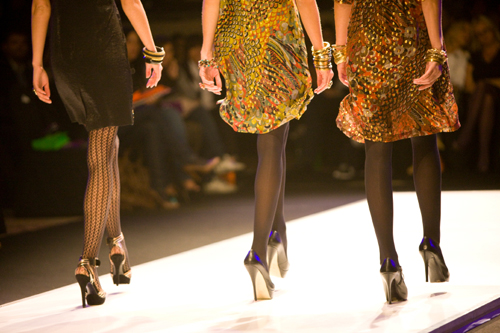BY VIVIAN MCINERNY | OB BLOGGER
 Two competing fashion show producers aim to shine in the Portland market.
Two competing fashion show producers aim to shine in the Portland market.
BY VIVIAN MCINERNY | OB BLOGGER
 Fashion shows are like diamonds. They’re relatively rare, require lots of time and pressure to produce and their actual value is difficult to assess.
Fashion shows are like diamonds. They’re relatively rare, require lots of time and pressure to produce and their actual value is difficult to assess.
Two competing fashion show producers aim to shine in the Portland market.
Tod Foulk, Chris Cone and Tito Chowdhury once were partners in Portland Fashion Week. The organization can trace its roots to 2003. Foulk took over in 2005. Cone and Chowdhury joined in 2006. That partnership officially dissolved earlier this year. Foulk kept the Portland Fashion Week name. Chowdhury had already launched FashioNXT in 2012 before the papers on the separation were signed. Cone has quietly walked away from both.
“They had been together a long time, and eventually people want to do things differently with the brand,” says Jessica Kane, executive director of Portland Fashion Week, which hosted several shows in the Oregon Convention Center in September.
Their differences may be reflected, appropriately enough, in their fashion differences. For years, Foulk sported a folksy long gray ponytail, cowboy hat and boots. Chowdhury favors boy-band hair, slim-fitting dress shirts and designer jeans.
Foulk is pleased “with the new energy” that Jessica Kane and Sarabeth Chambers brought to Portland Fashion Week. They added bridal, plus-size and student designs to the mix of clothing by independent regional designers on the runway. Most notably, they also included current-season clothes from retailers. That’s very different from the one-of-a-kind samples modeled for merchants and media at fashion week capitals such as New York, Paris and Milan.
In some ways, the more pedestrian approach makes perfect sense in Portland. Most people attend fashion shows for entertainment purposes only. But it is philosophically opposed to what Chowdhury strived so hard to achieve in his time at PFW and now through FashioNXT, which runs October 9-12.
“It is about inspiration! It’s about ideas! You can’t have that excitement at a Nordstrom show,” he says.
Chowdhury is more interested in creating a kind of stylish version of a TED conference.
He gets genuinely excited when talking of the latest advances in wearable technology and sustainability and how it can be integrated with fashion. He sees the connections between seemingly disparate things and is always more than eager to share his vision, and a bit baffled by those who don’t.
“I am trying to create a platform that blurs the lines,” he says of FashioNXT.
Chowdhury, despite being a full time engineer who works on advanced computer microprocessors at Intel, is a powerhouse promoter. He’s part of the reason Portland Fashion Week received attention in publications including the Wall Street Journal and Time magazine. The emphasis then was on green fashion, a more natural fit for Oregon.
FashioNXT aims to connect fashion creatives with technology and marketing. Case in point: Designer Seth Aaron Henderson made collections inspired and sponsored by Intel Cloud Technology and SolarWorld in the past. This year a designer (as of yet unnamed) is making use of a spectacular, illuminated, hi-tech material worthy of a Hunger Games gown. Another constructed stainless steel jewelry using a 3-D printer.
The fashions and tech accessories shown will come not only from Portland but also throughout the U.S. and Southeast Asia. Several past participants of the hugely popular Project Runway television show, including Henderson, are sure to draw fans to FashioNXT in October to be the first to see their Spring 2014 collections.
Both Portland Fashion Week and FashioNXT face challenges. The expense of producing a single show — venue, staging, lighting, promotion, models, dressers, hair, and makeup stylists – can easily climb to tens of thousands of dollars. Even given sponsorships, ticket sales, vendor fees, and the fact that many participants will volunteer services for experience and publicity, it cannot be easy to turn a profit.
Starting next week, FashioNXT plans four nights of shows. A month ago, Portland Fashion Week hosted six runway shows in three days at the Oregon Convention Center in September at a venue that seated 1,000. They also tied in with fashion shows and events elsewhere in the city that week, and intend to become a semi-annual event. Foulk produces additional fashion events and awards under Semper Fashion.
To complicate matters, some of Oregon’s top indie designers, preferring to remain independent, host their own private shows.
That is a whole lot of fashion for one town to take.
Granted, this is a golden time for fashion that has less to do with innovative design or stellar sales than the fact that fashion itself is fashionable. It sounds silly but it is true.
There have been times when pop culture all but ignored the industry. Now celebrities shout out designer names at red carpet events. Runway shows in New York City have become paparazzi-crazed circus scenes. And a television series about emerging designers is a smash hit. Once viewed as bourgeois, fashion is now routinely touted as “democratic.” So maybe it’s only natural that Portland should end up a teeming mass of fashion.
After all, one size can’t possibly fit all.

